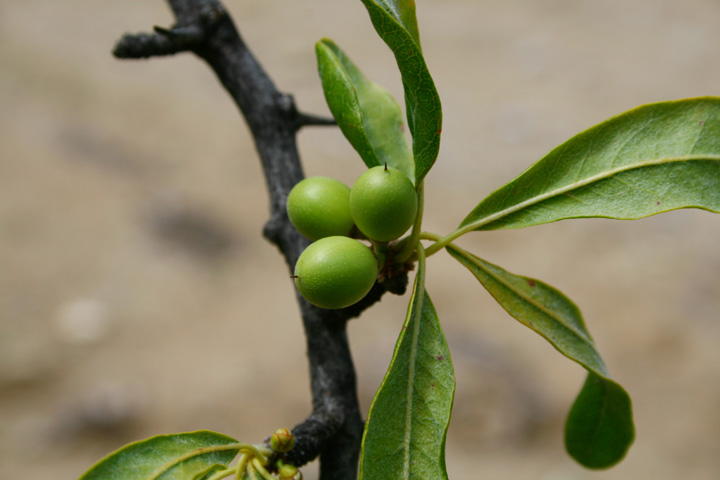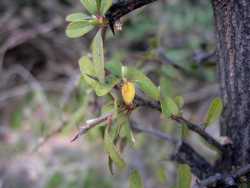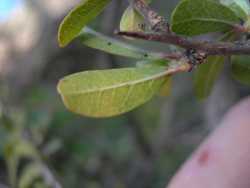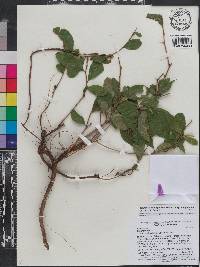|
|
|
|
Family: Sapotaceae
gum bully
[Bumelia lanuginosa (Michx.) Pers.] |
Shrubs or trees, to 15 m. Stems not armed or armed, villous, glabrescent. Leaves deciduous; petiole 2-14 mm, villous or sparsely hairy to glabrate; blade (dull to lustrous adaxially), oblong or oblanceolate to spatulate, 15-97 × 7-40 mm, base acute to attenuate, margins plane, apex rounded to obtuse, rarely acute, abaxial surface usually villous, rarely glabrate, venation visible, midrib villous (hairs white or gray to tawny, entangled, wavy), adaxial surface glabrate (hairs scattered along midribs), midrib flat, marginal vein absent. Inflorescences 7-17-flowered. Pedicels 2-7 mm, villous, rarely glabrous. Flowers: calyx 1.9-3.2 mm diam.; sepals (4-)5, 1.8-2.8 × 1.4-1.9 mm, lanate-villous; petals (4-)5(-6), white, median segment oblong to ovate, 1.2-1.8 mm, lateral segments lanceolate or falcate, 0.8-1.8 mm; stamens 5(-6), 2.5-2.8 mm; staminodes lanceolate, 1.3-2.5 mm, entire or erose; anthers sagittate, 0.8-1.2 mm; pistil 5(-8)-carpellate; ovary 5(-8)-locular, 1-1.2 mm, strigose; style 1.1-1.5 mm. Berries purplish black, broadly ellipsoid to obovoid, 7-12 mm, glabrate. Seeds 6-11 mm. Sideroxylon lanuginosum is the most widespread and morphologically variable North American species of the genus. Segregate species, subspecies, and varieties have been recognized based on variation in thorn presence, leaf size, abaxial leaf indument, and color of the leaf hairs. Based on our observations and those of A. Cronquist (1945c) and T. D. Pennington (1990), morphological variants are generally consistent within regions. Most recent authors have recognized three to five subspecies and/or varieties in S. lanuginosum (e.g., D. S. Correll and M. C. Johnston 1970; J. T. Kartesz and K. N. Gandhi 1990; B. L. Turner et al. 2003). We recognize three subspecies without varieties based on differences in leaf size and hair color on the abaxial leaf surfaces. A. Cronquist (1949) and T. D. Pennington (1990) also recognized three subspecies; Cronquist further divided subsp. oblongifolium by hair color (variants with white hairs = var. albicans) and the smaller-leaved subsp. rigidum by density of indument (less hairy variants = var. texanum). Discriminating among leaf surface hair densities and the white to gray hair color continuum is particularly difficult in areas of parapatry and sympatry among subspecies in Oklahoma, Texas, and northern Mexico. We present a conservative treatment and encourage detailed studies of morphological and molecular variation throughout the range of the S. lanuginosum complex.
Plant: shrub or small tree; 1-5 m high, the bark rough and scaly, dark brown; hairs whitish to pale yellowish, fine, more or less appressed and matted; young twigs tomentose, soon glabrate, the older twigs gray to blackish, rigid, usually terminating in a thorn, typically with stout straight or recurved lateral thorns (short shoots) 0.5-2 cm long Leaves: oblong-lanceolate, elliptic, obovate, or oblanceolate, 1.5-4.5 cm long, solitary or on older, slow-growing twigs, aggregated at nodes on short lateral shoots, subcoriaceous, tomentose to subglabrous below, sparsely pubescent to glabrous above; apex obtuse to rounded; base acute; petiole 1-4 mm long Flowers: 2-3 mm long, aggregated in umbel-like clusters of up to ca. 20 at older nodes; pedicels 1-3 mm long; sepals broadly rounded, pubescent externally; corolla whitish, glabrous, ca. 3 mm long; stamens 5 Fruit: FRUITS subglabrous, up to ca. 1 cm long, the pericarp thin, brittle when dry, slightly lustrous, greenish, 1(-2)-seeded; SEED smooth, the scar nearly always basal or basi-ventral Misc: In thickets along stream bottoms or washes in oak or mesquite woodlands; 900-1500 m (3000-5000 ft); May-Jul (fr. Sep-Oct) REFERENCES: Landrum Leslie R. 1992. Sapotaceae. Ariz.-Nev. Acad. Sci. 26(1)2. Much like no. 1 [Bumelia lanuginosa (Michx.) Pers.]; lvs oblanceolate to sometimes obovate or elliptic, the larger ones mostly 5-10 נ1.5-3.5 cm, loosely woolly-villous with persistent gray hairs beneath; pedicels often hairy; 2n=24. Dry or rocky woods; Fla. to Tex. and n. Mex., n. to Mo. and Kans. June, July. Our plant, as here described, is var. oblongifolia (Nutt.) R. B. Clark. Gleason, Henry A. & Cronquist, Arthur J. 1991. Manual of vascular plants of northeastern United States and adjacent Canada. lxxv + 910 pp. ©The New York Botanical Garden. All rights reserved. Used by permission. Landrum 1992 Common Name: gum bully Duration: Perennial Nativity: Native Lifeform: Tree Wetland Status: FACU General: Large shrubs to small trees 1-5 m tall, the bark rough and scaly, dark brown, with whitish to pale yellowish hairs, appressed and matted; young twigs tomentose, older twigs gray to blackish, rigid, terminating in a thorn, usually stout, straight or recurved lateral thorns 0.5-2 cm long. Leaves: Oblong-lanceolate, elliptic, obovate, or oblanceolate, 1.5-4.5 cm long, solitary or an older, slow-growing twigs, aggregated at nodes on short lateral shoots, tomentose to subglabrous below, sparsely pubescent to glabrous above; apex obtuse to rounded, acute base, petiole 1-4 mm long. Flowers: Aggregated in umbel-like clusters of up to 2 at older nodes; pedicels 1-3 mm long, sepals broadly rounded, pubescent externally; corolla whitish, glabrous about 3 mm long, with 5 stamens. Fruits: Subglabrous berry, up to 1 cm long, thin pericarp, brittle when dry, slightly lustrous, greenish. Ecology: Found in thickets along stream bottoms, or washes from 3,000-5,000 ft (914-1524 m); flowers from May-July. Distribution: Most of southern US, from AZ east to SC, north to MO; south to MEX. Notes: A large shrub to small tree with dark-colored branches and burly spines; and clusters (short shoots) of leaves with densely-long-hairy undersides (sometimes becoming glabrous) which emerge directly above thorns. Ethnobotany: Outer bark yields a substance that was used as a chewing gum. Etymology: Sideroxylon comes from the Greek sideros, iron and xyolon, for wood, while languinosum means woolly or downy. Synonyms: None, but there are a number of subspecies and varieties Editor: SBuckley 2010, FSCoburn 2015 |





